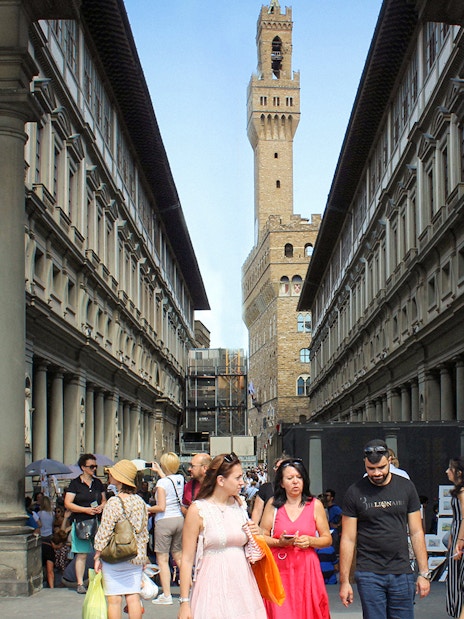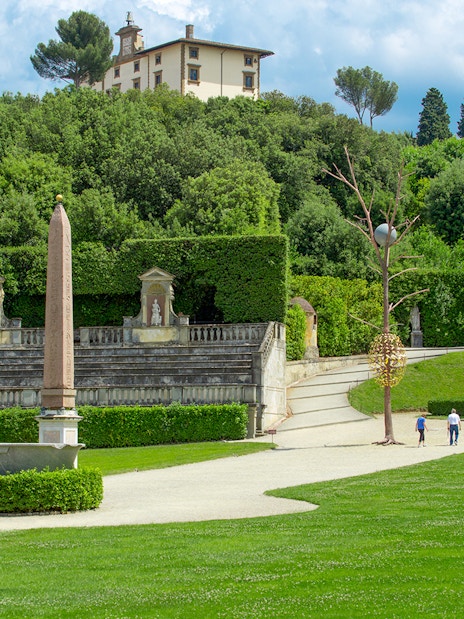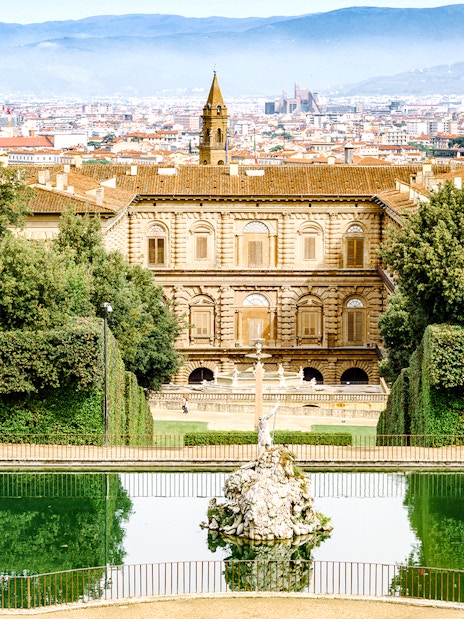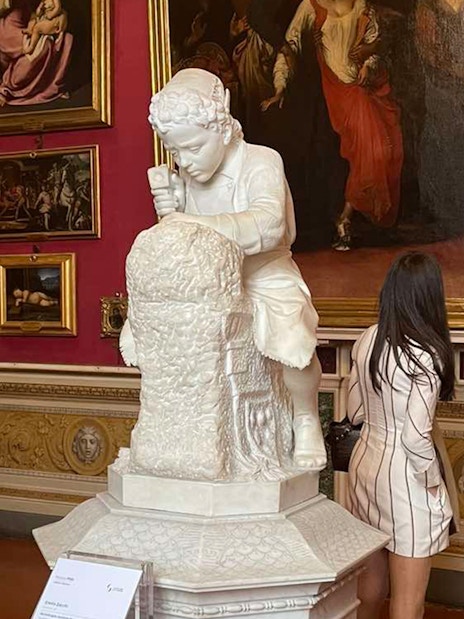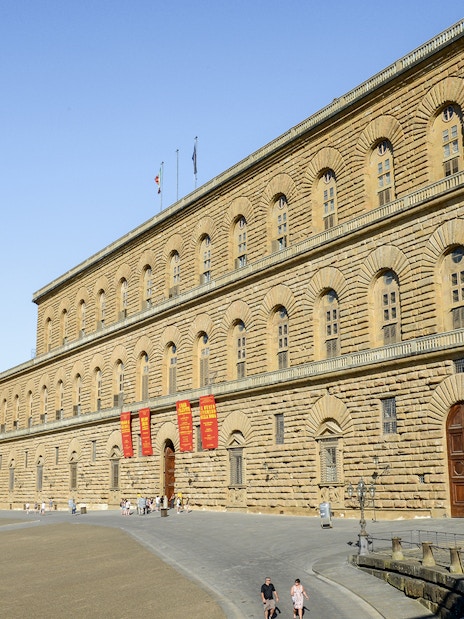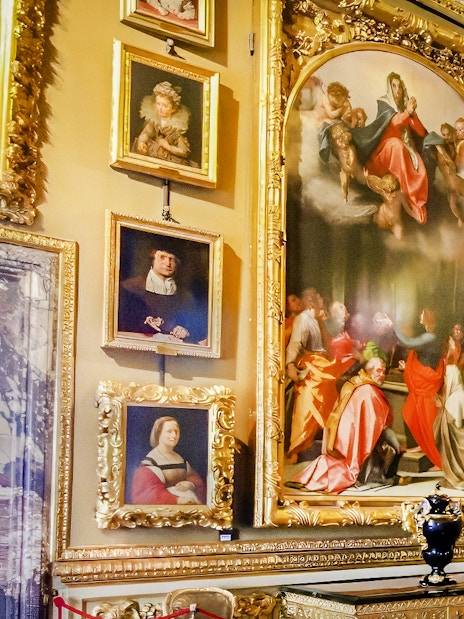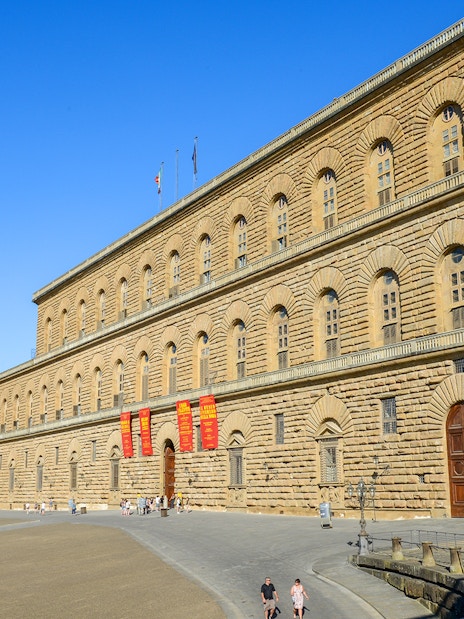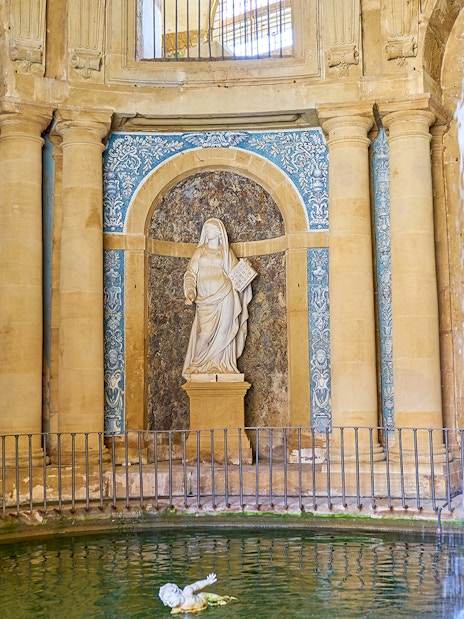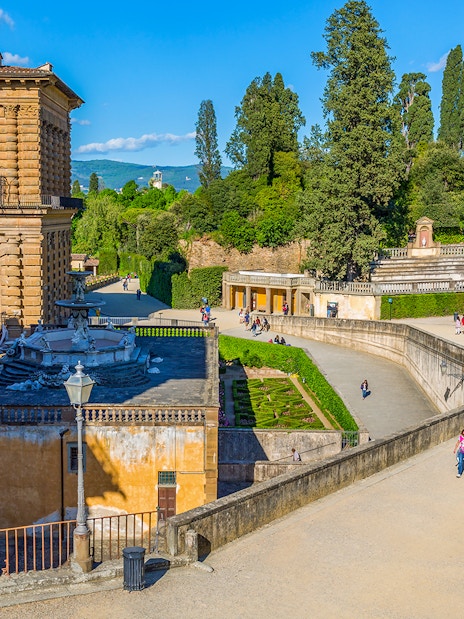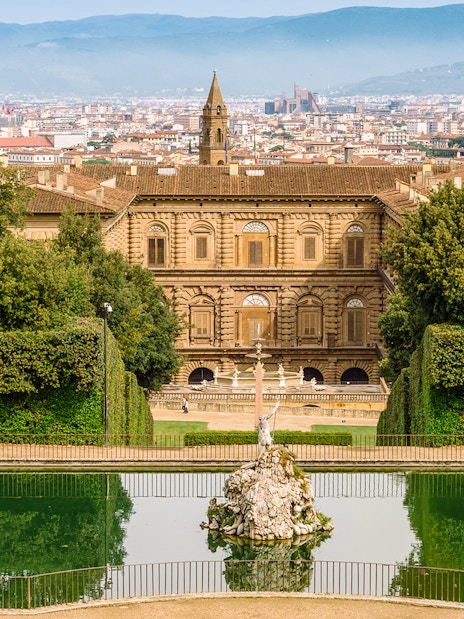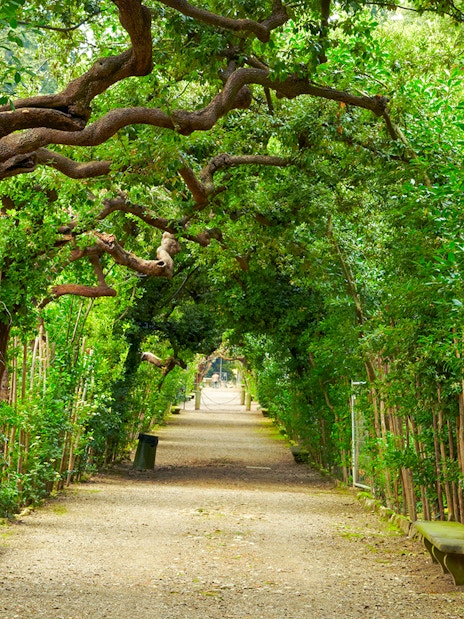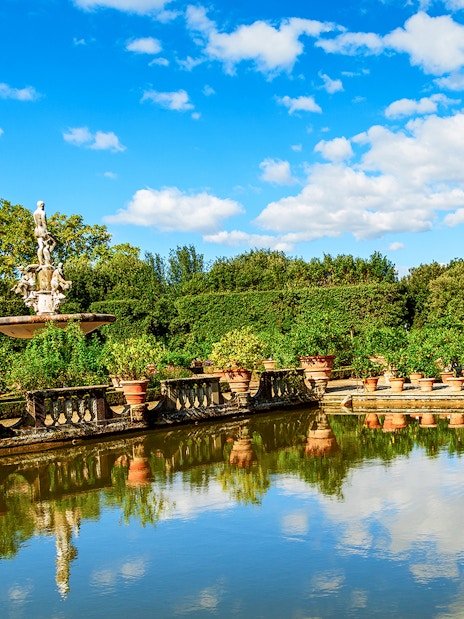One of the top highlights of Boboli Gardens is the Kaffeehaus that was built between 1774 and 1785. It was used as a resting place where the court could enjoy a hot cup of chocolate on their walks.
- Uffizi Gallery
- Duomo Florence
- Accademia Gallery Tickets
- Pitti Palace and Boboli Gardens
- Palazzo Vecchio
- Florence To Chianti Tours
- Florence To Cinque Terre Tours
- Bargello National Museum
- Medici Chapel
- Florence To Pisa Tours
- Florence To Siena Tours
- Florence To Tuscany Tours
- Hzero - The Miniature Railway
- San Marco Museum
- Basilica of Santa Croce
- Brancacci Chapel
Boboli Gardens Tickets & Tours
Headout is an authorized and trusted partner of the venue, offering curated experiences to enjoy this attraction. This is not the venue's website.

Pitti Palace & Palatine Gallery, Boboli & Bardini Gardens Skip-the-Line Tickets
- Get direct entry to 3 of Florence's most alluring sights, Pitti Palace, Palatine Gallery, and Boboli Gardens, with a single combo ticket.
- Skip long ticketing lines to the opulent residence of former grand dukes and monarchs, where Renaissance art, architecture and nature merge.
- Stroll through the art haven of Palatine Gallery, with an assortment of historic artifacts, and gorgeous artworks like The Three Ages of Man by Giorgione.
- Meander through the sprawling Boboli Gardens, a tranquil Medici paradise of ponds, statues, and ancient holm oak trees.
- Get direct entry to 3 of Florence's most alluring sights, Pitti Palace, Palatine Gallery, and Boboli Gardens, with a single combo ticket.
- Skip long ticketing lines to the opulent residence of former grand dukes and monarchs, where Renaissance art, architecture and nature merge.
- Stroll through the art haven of Palatine Gallery, with an assortment of historic artifacts, and gorgeous artworks like The Three Ages of Man by Giorgione.
- Meander through the sprawling Boboli Gardens, a tranquil Medici paradise of ponds, statues, and ancient holm oak trees.
Inclusions
- Skip-the-line entry to Pitti Palace
- Skip-the-line entry to Boboli Gardens
- Access to Palatine Gallery
- Access to Bardini Gardens
- Access to Porcelain Museum
Exclusions
- Guide
- Transfers
- Access to the Grotta del Buontalenti at Boboli Gardens
- Tip: When at Boboli, explore the Knight's Garden, an area with geometric flower beds and a charming fountain.
- Keep in mind food & beverages are not allowed in the exhibition areas.
- Mobile phones must be turned off or at least placed in silent mode.
- It is forbidden to run or walk barefoot in the museum premises.
- Shutterbugs, take note: Photography with any professional equipment including the use of flash and drones is a no-go inside the venue.
- Pets cannot tag along for this experience, with the exception of guide dogs and service animals, properly leashed and with a public medical certificate.
- From the square, the climb to the entrance of the Pitti Palace is rather steep (with a maximum gradient of 20%), so an accompanying person is recommended for wheelchair users or persons with reduced mobility.
- From the courtyard, you can take the stairs or lifts to access the Palatine Gallery (1st floor). The lifts are located on the right side near the cloakroom.
- The entire Boboli Gardens area is pedestrianized, and is not accessible by vehicle; if you have a disability badge, you can park nearby.
- Facilities: free cloakroom storage.
- Backpacks, bags, umbrellas and other large objects must be stored in the cloakroom prior to entry.
- Guests under the age of 12 years must be accompanied by an adult.
- You can cancel these tickets up to 24 hours before the experience begins and get a full refund.
- Prepare for an artistic curation in the epicenter of Florence! 1 ticket opens the doors to Uffizi Gallery, Pitti Palace, Palatine Gallery, and the Boboli Gardens.
- Forget about planning woes over a leisurely 5 days and immerse yourself along the Arno River’s banks—from Renaissance opulence to green escapes.
- Uffizi Gallery is home to seminal masterpieces, like Primavera by Boticelli and Raphael’s numerous portraits of Madonna.
- Wander among sculptures, fountains and 100-year-old holm oak trees at Boboli Gardens, a manicured Medici paradise!
- Pitti Palace, right in front of the gardens, is a complex of museums, including the Palatine Gallery. Get lost amidst works like Sleeping Cupid by Carravaggio.
- Prepare for an artistic curation in the epicenter of Florence! 1 ticket opens the doors to Uffizi Gallery, Pitti Palace, Palatine Gallery, and the Boboli Gardens.
- Forget about planning woes over a leisurely 5 days and immerse yourself along the Arno River’s banks—from Renaissance opulence to green escapes.
- Uffizi Gallery is home to seminal masterpieces, like Primavera by Boticelli and Raphael’s numerous portraits of Madonna.
- Wander among sculptures, fountains and 100-year-old holm oak trees at Boboli Gardens, a manicured Medici paradise!
- Pitti Palace, right in front of the gardens, is a complex of museums, including the Palatine Gallery. Get lost amidst works like Sleeping Cupid by Carravaggio.
Inclusions
- Entry to Uffizi Gallery
- Entry to Pitti Palace & Palatine Gallery
- Entry to Boboli Gardens
- Entry to the Museum Opificio Delle Pietre Dure
- Entry to the National Archaeological Museum of Florence
Exclusions
- Live guide
- Tip: Break a little sweat climbing to the top of Belvedere Fort, which sits on the Boboli Gardens’ highest hill! The panoramas of Florence are worth the hike.
- The optional audio guide for Uffizi is available in English, Italian, French, Spanish, German, Russian, Japanese, Chinese, Turkish, Portuguese, Polish, Dutch, and Korean.
- Shutterbugs, take note: Photography with any professional equipment including the use of flash and drones is a no-go inside the venue.
- Pets cannot tag along for this experience, with the exception of guide dogs and service animals, properly leashed and with a public medical certificate.
- The accessible entrance to Uffizi Gallery is located at Door 1 under the colonnade (the accessible ramp to the colonnade is in Via della Ninna). At the end of the corridor, an elevator that leads directly to the 2nd floor of the Gallery.
- Guests requiring entry with motorized wheelchairs, electric scooters or other large devices should contact the reception staff, who will direct them to the Uffizi concierge desk.
- From the square, the slope to the entrance of the Pitti Palace is rather steep (with a maximum gradient of 20%), so a companion is recommended for wheelchair users.
- From the courtyard, you can take the stairs or lifts to access the Palatine Gallery (1st floor). The lifts are located on the right side near the cloakroom.
- The entire Boboli Gardens area is pedestrianized, and is not accessible by vehicle; if you have a disability badge, you can park nearby.
- Facilities: free cloakroom storage.
- Backpacks, bags, umbrellas and other large objects must be stored in the cloakroom prior to entry.
- Guests under the age of 12 years must be accompanied by an adult.
- You can cancel these tickets up to 48 hours before the experience begins and get a full refund.
- Skip the lines and delve into the Pitti Palace, Palatine Gallery and Boboli Gardens with a passionate guide, unlocking Renaissance secrets.
- Walk in the footsteps of the Medici, Florence's most powerful family, with exclusive access to their grand residence, the Pitti Palace.
- See iconic works by Raphael, Pietro Perugino, and Riminaldi, housed in the opulent Palatine Gallery, alongside captivating frescoes.
- Escape the crowds on a stroll through the Boboli Gardens, once a playground of Medici nobles. Be sure to look for hidden grottos!
- A small group tour means personalized attention and ample time to ask questions, ensuring an enriching and interactive experience.
- Skip the lines and delve into the Pitti Palace, Palatine Gallery and Boboli Gardens with a passionate guide, unlocking Renaissance secrets.
- Walk in the footsteps of the Medici, Florence's most powerful family, with exclusive access to their grand residence, the Pitti Palace.
- See iconic works by Raphael, Pietro Perugino, and Riminaldi, housed in the opulent Palatine Gallery, alongside captivating frescoes.
- Escape the crowds on a stroll through the Boboli Gardens, once a playground of Medici nobles. Be sure to look for hidden grottos!
- A small group tour means personalized attention and ample time to ask questions, ensuring an enriching and interactive experience.
Inclusions
- Guided tour of Pitti Palace, Palatine Gallery & Boboli Gardens with entry
- Expert English-speaking guide
- Headsets for groups of 3+
- Tip: Head to Piazzale Michelangelo, a short walk from Pitti Palace, for panoramic views of Florence bathed in the golden hues of the setting sun.
- Safety is a priority so this experience is restricted for guests under the age of 5 years and over the age of 80 years.
- Nobody likes a crowd. A single group has a maximum of 12 people.
- Keep in mind food & beverages are not allowed in the exhibition areas.
- Mobile phones must be turned off or at least placed in silent mode.
- It is forbidden to run or walk barefoot in the museum premises.
- Shutterbugs, take note: Photography with any professional equipment including the use of flash and drones is a no-go inside the venue.
- Pets cannot tag along for this experience, with the exception of guide dogs and service animals, properly leashed and with a public medical certificate.
- From the square, the slope to the entrance of the Pitti Palace is rather steep (with a maximum gradient of 20%), so a companion is recommended for wheelchair users.
- From the courtyard, you can take the stairs or lifts to access the Palatine Gallery (1st floor). The lifts are located on the right side near the cloakroom.
- The entire Boboli Gardens area is pedestrianized, and is not accessible by vehicle; if you have a disability badge, you can park nearby.
- Facilities: free cloakroom storage.
- Backpacks, bags, umbrellas and other large objects must be stored in the cloakroom prior to entry.
- You can cancel these tickets up to 24 hours before the experience begins and get a full refund.
- Combine your stroll through an entire district filled with Medici family constructions with convenient entry to the Boboli Gardens.
- Pass by Palazzo Vecchio, Florence's town hall, which overlooks Signoria Square! Spot Vasari's Corridor and learn of its history from an expert guide.
- The gardens hold numerous species of ornamental flowers, huge sculptural waterworks like the Artichoke Fountain, and quirky buildings like the Kafeehaus.
- Tree branch archways offer perfect shade and mesmerizing foliage, many of which are found in Cypress Lane.
- Combine your stroll through an entire district filled with Medici family constructions with convenient entry to the Boboli Gardens.
- Pass by Palazzo Vecchio, Florence's town hall, which overlooks Signoria Square! Spot Vasari's Corridor and learn of its history from an expert guide.
- The gardens hold numerous species of ornamental flowers, huge sculptural waterworks like the Artichoke Fountain, and quirky buildings like the Kafeehaus.
- Tree branch archways offer perfect shade and mesmerizing foliage, many of which are found in Cypress Lane.
Inclusions
- Guided tour of the Medici district
- Entry Boboli Gardens
- Access to the Porcelain Museum & Bardini Gardens
- Expert English or Spanish-speaking guide
- Multilingual assistance at the meeting point
Exclusions
- Guided tour of Boboli Gardens
- Pro tip: Drinking fountains are located near the Garden of Madama, the Knight's Garden, the Grotto of Adam and Eve, and the Meadow of the Columns at Boboli.
- Shutterbugs, take note: Photography with any professional equipment including the use of flash and drones is a no-go inside the venue.
- Pets cannot tag along for this experience, with the exception of guide dogs and service animals, properly leashed and with a public medical certificate.
- The entire Boboli Gardens area is pedestrianized, and is not accessible by vehicle; if you have a disability badge, you can park nearby.
- Guests under the age of 12 years must be accompanied by an adult.
- You can cancel these tickets up to 24 hours before the experience begins and get a full refund.
Combo (Save 9%): Florence Cathedral + Pitti Palace & Boboli Gardens Tickets
9% off
- Uncover 2 distinct legacies in Florence with tickets to Santa Maria del Fiore Cathedral and the Medici wonders, Pitti Palace and Boboli Gardens!
- Visit the cathedral complex over 3 days, including the Opera Museum and St. John’s Baptistery. Upgrade to scale Brunelleschi’s Dome and Giotto’s Bell Tower.
- Set foot into the former regal residence Pitti Palace, exploring the museums and Royal Apartments. Also enjoy the serene Bardini Gardens!
- See dramatic mythic battles like Apollo flaying Marsyas by Giovanni Bilivert to coy portraits like Painting and Poetry by Francesco Furini at Palatine Gallery.
- The serene Boboli Gardens invites you to an intricately planned set of symmetrical woods, hidden caves, and sculptures.
- Uncover 2 distinct legacies in Florence with tickets to Santa Maria del Fiore Cathedral and the Medici wonders, Pitti Palace and Boboli Gardens!
- Visit the cathedral complex over 3 days, including the Opera Museum and St. John’s Baptistery. Upgrade to scale Brunelleschi’s Dome and Giotto’s Bell Tower.
- Set foot into the former regal residence Pitti Palace, exploring the museums and Royal Apartments. Also enjoy the serene Bardini Gardens!
- See dramatic mythic battles like Apollo flaying Marsyas by Giovanni Bilivert to coy portraits like Painting and Poetry by Francesco Furini at Palatine Gallery.
- The serene Boboli Gardens invites you to an intricately planned set of symmetrical woods, hidden caves, and sculptures.
Inclusions
Florence Cathedral
- Entry to Santa Maria del Fiore Cathedral
- Entry to the Crypt of Santa Reparata
- Entry to Opera del Duomo Museum & St. John's Baptistery
- Entry to Brunelleschi's Dome (optional)
- Entry to Giotto's Bell Tower (optional)
Pitti Palace, Palatine Gallery & Boboli Gardens
- Skip-the-line entry to Pitti Palace
- Skip-the-line entry to Boboli Gardens
- Access to Palatine Gallery
- Access to Bardini Gardens
- Access to Porcelain Museum
Florence Cathedral
- Tip: Check out the Pietà sculpture by Michelangelo at the Opera del Duomo Museum.
- Strict dress code: Clothing that covers the knees and shoulders. Sandals, headgear, and sunglasses are also not allowed.
- The Dome & Bell Tower are not accessible for wheelchair users, guests with mobility issues, back problems, or heart conditions.
- Please note that there are 463 steps to the top of the Dome, and 414 steps to the top of Giotto's Bell Tower, with no elevator access.
- The Opera Museum, Bell Tower, and Baptistery all have flexible entry. You'll be able to visit these sites within 72 hours of first use.
- Dome access is timed and must be visited on the date & time selected during checkout.
Pitti Palace and Boboli Gardens
- Tip: Watch out for the Isolotto at Boboli Gardens, an oval-shaped island in the middle of a pond, featuring fountains, statues and citrus trees!
- Keep in mind food & beverages are not allowed in the exhibition areas.
- Mobile phones must be turned off or at least placed in silent mode.
- It is forbidden to run or walk barefoot in the museum premises.
- Shutterbugs, take note: Photography with any professional equipment including the use of flash and drones is a no-go inside the venue.
- Pets cannot tag along for this experience, with the exception of guide dogs and service animals, properly leashed and with a public medical certificate.
- These tickets can't be cancelled or rescheduled.
Top things to do in Florence
Which Boboli Gardens ticket is best for you?

If you're short on time
Go for: Skip-the-line access
Duration: Flexible
Guided access: No
Pitti Palace access: Yes
- Bypass long queues at Pitti Palace and Boboli Gardens, saving valuable time and maximizing visit. It's a good balance between cost and coverage, exploring key highlights without extensive guided tours.
- This ticket grants access to multiple attractions like Palatine Gallery, Bardini Gardens, and the Porcelain Museum, offering a well-rounded experience without focusing solely on one site.
Recommended tickets:
- Pitti Palace, Palatine Gallery & Boboli Gardens Tickets

If you're looking to explore in-depth
Go for: Guided tours
Duration: 3 hours
Guided access: Yes
Pitti Palace access: Yes
- A guided tour offers in-depth knowledge and context about the historic Pitti Palace, Palatine Gallery, and Boboli Gardens, allowing you to tailor the experience to your interests for an enriching visit beyond the surface level.
- The tour streamlines your visit, ensuring you don't miss any highlights while avoiding potential confusion or overwhelm within the expansive palace and gardens.
Recommended tickets:
- Pitti Palace, Palatine Gallery & Boboli Gardens Guided Tour

If you're on budget
Go for: Combo tickets
Duration: Flexible
Guided access: Optional
Pitti Palace access: Yes
- Despite being pricier upfront, combo tickets grants access to multiple attractions over multiple days, making it a budget-friendly option for Florence expedition.
- The access extends beyond Pitti Palace and Boboli Gardens to other iconic Florence landmarks like the Uffizi Gallery and the Duomo Florence (including all it's famous sub-attractions), among others. With a longer validity period, this pass allows visitors to explore at their own pace.
Recommended tickets:
- Florence 5-Day Pass: Uffizi Gallery, Pitti Palace & Boboli Gardens Tickets
- Combo: Florence Cathedral Tickets + Pitti Palace & Boboli Gardens Guided Tour
Highlights of the Boboli Gardens
Kaffeehaus
Plan your visit to Boboli Gardens

- Opening hours from Monday to Sunday: 8:15 am
- Closing hours: January, February, November, December: 4:30 pm
March and October (Standard time): 5:30 pm
March (Daylight savings time), April, May, September, October (Daylight savings time): 6:30 pm
June, July, August: 7:10 pm - Last entry: One hour before the closing time
- Closing days: First and last Monday of each month, 25 December
Best time to visit
The gardens offer different experiences depending on the season. While spring are blooming with fragra lush greenery and the gorgeous purple flowers, summer can be hot and golden. Fall and winter visits offer quieter surroundings but may require extra precautions due to wet benches and colder temperatures.
Best visiting hours for Boboli GardensAddress: Piazza Pitti, 1 50125 Firenze FI
- By bus: Take lines C3, C4, 37, 6A, 11, 131
Nearest stop: Piazza San Felice - By tram: Take line T1
Nearest stop: Unita - By train: Take line R
Nearest stop: Santa Maria Novella - By car:
You can reach Boboli Gardens by car but there are a lot of traffic restrictions in the area and limited car parking spaces. To enter ZTL of Florence (limited traffic area), find a garage to leave your car to get your license plate registered and avoid fines.
Car Parks: The closest car park to Boboli Gardens is located near Porta Romana.

- Pitti Palace entrance: Straight from Palazzo Pitti courtyard to Boboli Gardens. All kinds of ticket holders can enter, including those with skip-the-line, guided tour, or audio-visual guide tickets. Another dedicated accessible entrance is also available at the left side of Pitti Palace courtyard.
- Belvedere Fort: The entrance reopened in July 2022, and can be found on one of the hills within the Boboli Gardens from the Belvedere Fort. It is open to all, including those with reduced mobility.
- Porta Romana: Located on the southern side of the gardens, an ancient gate built in the 13th century. Suited for everyone seeking a convenient and direct way to explore the Boboli Gardens.
- Via Romano (Annalena Entrance): Located near the Boboli Gardens Amphitheatre, also known as the Annalena Entrance, this entrance is halfway between Romana and Pitti entrances suitable for all tourists except those with reduced mobility.
Pro tip: Start your journey from the Porta Romana side and head towards the exit near Palazzo Pitti. Enjoy a serene start amidst tree-lined Violottone, before climbing for a panoramic view of Florence. Explore busier garden sections before heading to Bardini Gardens or descending towards Pitti Palace and central Florence.

- Restroom: Located at Annalena entrance, near the Amphitheatre, in the Porcelain Museum, and near the Garden of the "Hair Washer" Statue.
- Drinking fountain: Available near the Garden of Madama, Knight's Garden, Grotto of Adam and Eve, and Meadow of the Columns.
- Bookshop: Located in the courtyard of Pitti Palace.
- Baby pit-stop: Dedicated room for breastfeeding, changing, and relaxation in the basement, near the Amphitheatre.
- Cloakroom: Free service available on the right side of the Ammannati Court.

- All Boboli Gardens entrances support accessibility. Visitors with mobility impairments or special health needs can access the gardens via Door 1 under the colonnade, equipped with an elevator leading directly to the second floor.
- Free rental of wheelchairs and walkers is available at the ticket office, no booking or deposit required, subject to availability.
- Use of electric scooters is evaluated case-by-case for safety. Visitors may be asked to transfer to museum wheelchairs at no extra cost.
- Guide dogs for the blind and assistance dogs are permitted, provided they wear appropriate harnesses and leashes.
- Accessible toilets are available within the gardens, including one near the Chestnut Meadow area and another at the entrance to Annalena.
- Prams and pushchairs are allowed in the gardens, but they cannot be deposited in the cloakroom during the visit. Baby carriers are permitted, especially if small and worn on the front.

- Store large items in the cloakroom; metal detector inspection may be required.
- Groups limited to 16 people; tour guides must use whisper systems.
- Maintain good manners and moderate voices; modest clothing required.
- Visitors under 12 must be accompanied by an adult; silence mobile phones.
- Do not touch artworks; no leaning on sculptures or running in the museum.
- Eating, drinking, smoking, and flash photography are prohibited.
- No writing or littering; dispose of waste in designated bins.
- Prohibited items include knives, firearms, drones, and pets (except service animals).
- Submit LAG products for security check; comply with security personnel.
- Personal photography allowed without flash or tripods; commercial use requires authorization.
- Marriage proposals allowed but must not disturb other visitors or involve professional photographers.

- The gardens are huge, try downloading a map for efficient navigation, as not all points of interest are marked on standard mapping apps.
- It's good practice to visit 15 minutes before the time on your ticket.
- Boboli Gardens is a popular picnic spot with a beautiful city view. There's a dedicated picnic area on the eastern side between the Madama Grotto and the Fountain of Ganymede and a recently opened one near the Buontalenti Grotto.
- Food options inside the gardens are limited, so consider bringing your own snacks or picnic supplies. Remember that sugary drinks and wine are not permitted, but soft juice boxes for kids are usually allowed.
- When traveling with kids, keep an eye out for the bright green parakeets near the Porta Romana entrance, the large marble discs for climbing, and the face sculpture known as Tindaro Screpolato.
- If you're a teen group, do watch the film "Inferno," which features scenes shot in the Boboli Gardens. You can even try recreating some shots and make your own audition photobook for fun!

- Trattoria Ponte Vecchio - Enjoy stuffed pasta and Tuscan wines at this restaurant open from 11 AM to 11 PM daily.
- Winter Garden Restaurant - Winter Garden Restaurant specializes in delish Tuscan cuisine paired with local wines.
- Ristorante La Spada - Bite into grilled and roasted meats at the Ristorante La Spada.
- Ristorante Storico Sabatini - Ristorante Storico Sabatini is a Tuscan restaurant offering signature pasta recipes, Florentine steak, etc.
Beyond Boboli Gardens

Palazzo Pitti
Distance: 2 m
A Renaissance palace housing several museums, including the Palatine Gallery with its vast collection of Renaissance paintings.
Book Palazzo Pitti tickets
Uffizi Gallery
Distance: 650 m
One of the world's most renowned art museums, featuring masterpieces by Botticelli, Michelangelo, and Leonardo da Vinci, among others.
Book Uffizi Gallery tickets
Florence Cathedral
Distance: 1 km
Duomo Florence, also known as the Cathedral of Santa Maria del Fiore, is a magnificent Gothic masterpiece renowned for its iconic dome, frescoes, and intricate marble façade.
Book Duomo Florence ticketsFrequently asked questions about Boboli Garden tickets
The exact inclusions of a Boboli Gardens ticket depends upon the type of experience you've chosen. They typically include access to the gardens themselves, as well as neighboring and equally famed attractions like the Palazzo Pitti, Palatine Gallery, Porcelain Museum and Bardini Gardens. Do check the ticket details to confirm which additional sites are covered to make the most of your visit.
While skip-the-line tickets are not typically necessary for Boboli Gardens, they can be a lifesaver during peak tourist seasons when there are 1-2 hour longer queues at the ticket counters. Fortunately, most of our Boboli Gardens tickets include priority access.
Boboli Gardens offers free admission on the first Sunday of each month. But why wait for the first Sunday rush? Skip the crowds and plan the perfect peaceful retreat in the beautiful Boboli Gardens on quieter days.
Yes, you'd be asked to pick a slot when booking your ticket. This allows the management to control the flow of visitors and ensure a comfortable and safe experience for everyone. You can plan your visit on your schedule and avoid long queues. Typically these slots can't be rescheduled, so exercise some caution.
It’s a steal deal! Pairing your visit to the Boboli Gardens with Palazzo Pitti is the most recommended way to explore the best of these Florentine Renaissance treasures. Inside the Pitti Palace, marvel at legendary artworks and intriguing historical artifacts that have been cherished for centuries. Then, step outside into Boboli Gardens for a serene retreat—perhaps even a delightful picnic—set amidst stunning sculptures and meticulously manicured terraced gardens. It's the perfect blend of indoor retrospection and outdoor fun—a truly enriching experience that offers the best of both worlds in one delightful outing!
Children under 18 years old can enter the Boboli Gardens for free. Do note that children under 12 years must be accompanied by an adult.
While Boboli Gardens boast poetically beautiful landscapes, their layout across hilly terrain may pose challenges for individuals with mobility issues. Although there are some less gravelly paths available, wheelchair users may find themselves restricted to certain areas of the gardens. However, efforts have been made to enhance accessibility, including accessible entrances, ramps, and designated paths suitable for wheelchairs. Free wheelchair rental services are available on-site to facilitate exploration for all visitors.
Stroller accessibility is limited in Boboli Gardens due to its challenging terrain, it's advisable to bring a lightweight stroller that's easy to fold and carry. The gardens feature hilly terrain and stairs, making maneuvering difficult with bulky strollers. However, you can still explore some areas that have somewhat concrete pathways throughout these expansive gardens.
A few key highlights of the Boboli Gardens are Giorgio Vasari’s Large Grotto, Giambologna’s The Fountain of the Ocean, Neptune’s Fountain by Stoldo Lorenzi, and a 34-century old obelisk from Egypt.
Unfortunately, Boboli Gardens do not permit pets, except for service animals assisting visitors with disabilities. Therefore, if you plan to visit Boboli Gardens, it's best to leave your pets at home or make alternative arrangements for their care during your visit.
Boboli Gardens is THE perfect spot to have a hearty picnic with great Florence views! Set up your picnic in the designated area on the eastern side of the gardens, located between the Madama Grotto and the Fountain of Ganymede. While picnicking is allowed in this area, please be aware that sugary drinks, soda, and wine are not permitted inside the gardens.
Yes, there is a dress code for visiting Boboli Gardens. Visitors are required to wear clothing appropriate to the formal setting of the museum. This means that wearing bathing costumes, skimpy clothing, wedding dresses, period costumes, or any other fancy dress that is undignified for such places is considered inappropriate. Additionally, walking barefoot or bare-chested in the museum is strictly forbidden.
Sorry, re-entry to Boboli Gardens is typically not allowed. Once you leave the gardens, your visit is considered concluded, and you would need to purchase a new ticket if you wish to re-enter on another occasion. Therefore, it's essential to plan your visit accordingly and ensure you have ample time to explore all the attractions within the gardens before exiting.







